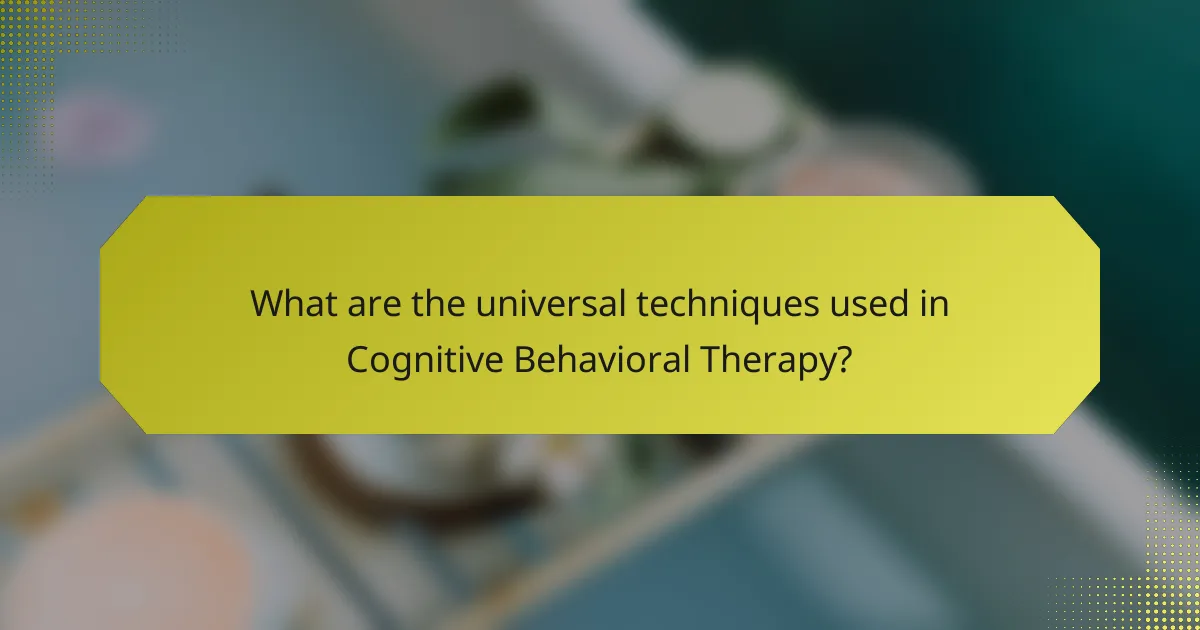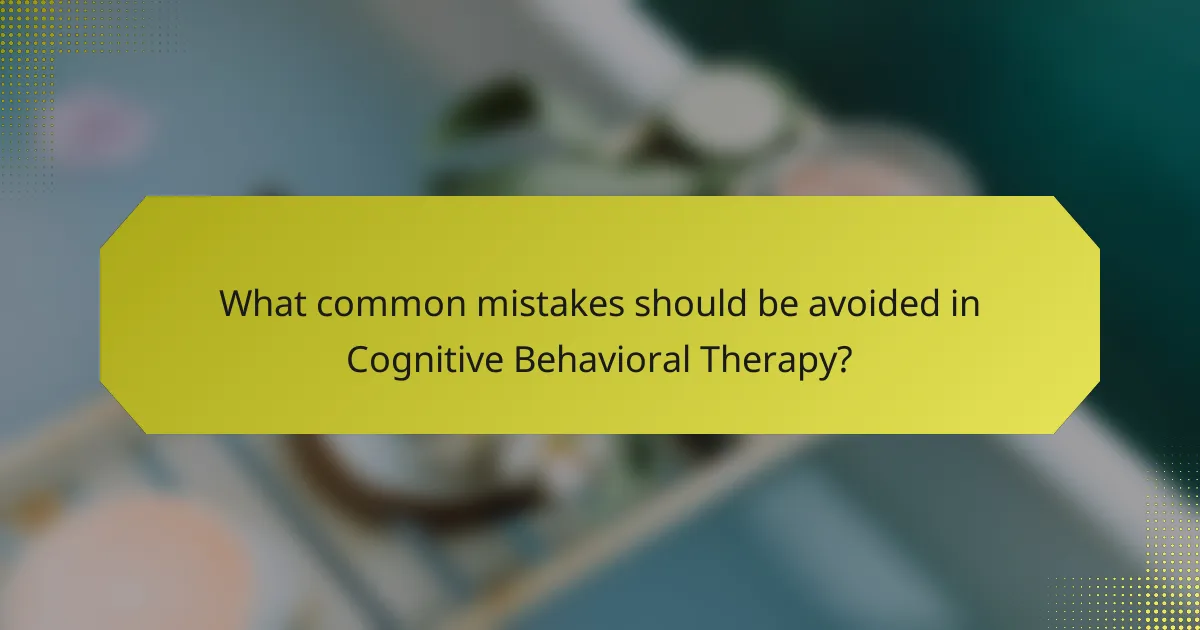Cognitive Behavioral Therapy (CBT) effectively reduces anxiety and improves mood through structured techniques. This article explores key CBT techniques like cognitive restructuring and exposure therapy, outlines its benefits including enhanced coping skills, and provides valuable resources for further learning. Emphasizing best practices and common pitfalls, the content aims to equip readers with a comprehensive understanding of CBT’s application in mental health.

What is Cognitive Behavioral Therapy?
Cognitive Behavioral Therapy (CBT) is a structured, goal-oriented psychotherapy that focuses on changing negative thought patterns. Techniques include cognitive restructuring, exposure therapy, and behavioural activation. Benefits encompass reduced anxiety, improved mood, and enhanced coping skills. Resources for CBT include self-help books, online courses, and trained therapists.
How does Cognitive Behavioral Therapy work?
Cognitive Behavioral Therapy (CBT) works by identifying and changing negative thought patterns and behaviours. It employs techniques such as cognitive restructuring and exposure therapy to help individuals manage their emotions and improve mental health. CBT is structured and goal-oriented, often leading to measurable improvements in symptoms. Research shows that CBT can be effective for various conditions, including anxiety and depression, making it a valuable resource for therapeutic intervention.
What are the key principles of Cognitive Behavioral Therapy?
Cognitive Behavioral Therapy (CBT) is based on key principles that focus on the connection between thoughts, feelings, and behaviours. These principles include cognitive restructuring, which involves identifying and challenging negative thought patterns, and behavioural activation, encouraging engagement in positive activities. Another crucial principle is the emphasis on skill development, teaching clients coping strategies to manage stress and anxiety. Additionally, CBT promotes goal-setting to track progress and reinforce positive changes.

What are the universal techniques used in Cognitive Behavioral Therapy?
Cognitive Behavioral Therapy employs several universal techniques to help individuals manage their thoughts and behaviours effectively. Key techniques include cognitive restructuring, exposure therapy, behavioural activation, and mindfulness practices.
Cognitive restructuring involves identifying and challenging negative thought patterns. Exposure therapy helps individuals confront fears in a controlled manner. Behavioural activation encourages engagement in enjoyable activities to combat depression. Mindfulness practices promote present-moment awareness, reducing anxiety.
These techniques collectively enhance emotional regulation and foster healthier coping strategies.
How is cognitive restructuring applied in sessions?
Cognitive restructuring is applied in sessions through guided techniques that help clients identify and challenge negative thought patterns. Therapists facilitate this process by encouraging clients to reframe their thoughts, fostering a more balanced perspective. Techniques may include thought records, cognitive reframing, and Socratic questioning. Each session typically focuses on specific situations where cognitive distortions arise, helping clients develop healthier thinking habits over time.
What role does exposure therapy play in treatment?
Exposure therapy is a key technique in cognitive behavioural therapy that helps individuals confront and reduce anxiety by gradually exposing them to feared situations. This method allows patients to process their fears in a controlled environment. Research indicates that exposure therapy can significantly decrease symptoms of anxiety disorders, including phobias and PTSD. The unique attribute of this therapy is its focus on real-life experiences, which enhances emotional processing and resilience. As a result, exposure therapy is often a vital component of comprehensive treatment plans.
How can behavioural activation improve outcomes?
Behavioural activation significantly enhances outcomes in Cognitive Behavioral Therapy by encouraging active engagement in meaningful activities. This approach reduces depressive symptoms by promoting positive behaviours and breaking the cycle of inactivity. Studies show that patients who practice behavioural activation report improved mood and overall well-being. As a result, it effectively complements traditional cognitive techniques, making therapy more robust and impactful.

What unique benefits does Cognitive Behavioral Therapy offer?
Cognitive Behavioral Therapy offers unique benefits such as personalised treatment strategies and a focus on practical skills. It empowers individuals to identify and challenge negative thought patterns, leading to improved emotional regulation. As a result, clients often experience reduced anxiety and depression symptoms, enhanced coping mechanisms, and increased overall resilience. This therapy is particularly effective for various mental health conditions, showcasing its adaptability and broad applicability.
How does it address anxiety disorders specifically?
Cognitive Behavioral Therapy (CBT) effectively addresses anxiety disorders by identifying and altering negative thought patterns. Techniques such as cognitive restructuring and exposure therapy help patients confront fears and reduce anxiety symptoms. Research shows that CBT can lead to significant improvements, with up to 60-80% of patients experiencing reduced anxiety after treatment. This approach not only targets immediate symptoms but also equips individuals with coping strategies for long-term management.
What advantages does it provide for depression management?
Cognitive Behavioral Therapy (CBT) offers significant advantages for depression management. It equips individuals with practical skills to challenge negative thoughts, enhancing emotional resilience.
CBT is structured, typically lasting 12 to 20 sessions, allowing for measurable progress. Studies show that about 60% of patients experience symptom reduction after completing CBT. Additionally, it can be delivered in various formats, including individual, group, or online sessions, increasing accessibility.
Unique to CBT is its focus on present thoughts and behaviours rather than past experiences, making it particularly effective for those seeking immediate coping strategies. As a result, many practitioners recommend CBT as a first-line treatment for depression, emphasizing its evidence-based effectiveness.
How effective is it for chronic pain management?
Cognitive Behavioral Therapy (CBT) is effective for chronic pain management by addressing the psychological aspects of pain. Research shows that CBT can significantly reduce pain perception and improve coping strategies. A meta-analysis found that CBT leads to a 30% reduction in chronic pain symptoms for many patients. This therapy focuses on modifying negative thought patterns, enhancing emotional regulation, and fostering behavioural changes that contribute to pain relief. Additionally, CBT equips individuals with tools to manage stress, which can exacerbate pain conditions.

What are the rare attributes of Cognitive Behavioral Therapy?
Cognitive Behavioral Therapy (CBT) has rare attributes that enhance its effectiveness. One unique aspect is its adaptability to various cultural contexts, allowing for tailored interventions. Another rare attribute is the incorporation of technology, such as mobile apps for self-monitoring and support. Additionally, CBT can integrate mindfulness techniques, creating a hybrid approach that addresses both cognitive and emotional aspects of mental health. Lastly, the use of neurofeedback in some CBT practices represents a cutting-edge development that is not widely adopted but shows promise in treatment outcomes.
How does it integrate with other therapeutic modalities?
Cognitive Behavioral Therapy (CBT) integrates effectively with various therapeutic modalities, enhancing overall treatment outcomes. For example, combining CBT with mindfulness techniques can improve emotional regulation and reduce anxiety. Integrating CBT with medication management allows for a comprehensive approach to mental health, addressing both psychological and physiological aspects. Additionally, CBT can complement group therapy, fostering shared experiences and support among participants. This integration highlights CBT’s versatility and adaptability in diverse therapeutic settings.
What unique adaptations exist for children and adolescents?
Cognitive Behavioral Therapy (CBT) for children and adolescents includes unique adaptations tailored to their developmental stages. Techniques often involve play therapy, role-playing, and creative activities to engage younger clients effectively.
These adaptations enhance the therapeutic process by making it relatable and accessible. For instance, using stories or games can help convey complex concepts, allowing children to express emotions and thoughts in a safe environment.
Moreover, CBT for this age group emphasizes collaboration with parents or guardians, ensuring support extends beyond therapy sessions. This approach helps reinforce learned skills at home, maximizing the benefits of therapy.
Overall, the unique adaptations in CBT for children and adolescents focus on engagement, creativity, and family involvement, making it a powerful tool for addressing mental health issues in this demographic.
How is it tailored for culturally diverse populations?
Cognitive Behavioral Therapy (CBT) is tailored for culturally diverse populations through culturally sensitive adaptations. These adaptations consider unique cultural contexts, beliefs, and values, enhancing engagement and effectiveness. Techniques may include integrating culturally relevant examples and addressing specific cultural stressors. Training therapists in cultural competence is essential, ensuring they understand diverse backgrounds and communication styles. This approach improves therapeutic outcomes and fosters trust between clients and practitioners.

What resources are available for learning Cognitive Behavioral Therapy?
Cognitive Behavioral Therapy (CBT) resources include books, online courses, workshops, and professional training programs. Books like “Feeling Good” by David D. Burns provide foundational knowledge. Online platforms such as Coursera and Udemy offer structured courses. Workshops conducted by mental health organizations enhance practical skills. Additionally, certification programs from accredited institutions ensure comprehensive training in CBT techniques.
What are the best books on Cognitive Behavioral Therapy?
The best books on Cognitive Behavioral Therapy include “Feeling Good: The New Mood Therapy” by David D. Burns, which offers practical techniques for managing depression. Another notable title is “The CBT Toolbox: A Workbook for Clients and Clinicians” by Lisa Dion, providing hands-on exercises. “Cognitive Behavioral Therapy for Dummies” by Rhena Branch and Rob Willson serves as an accessible guide for beginners. “The Anxiety and Phobia Workbook” by Edmund J. Bourne offers strategies for anxiety management. Lastly, “Mind Over Mood” by Dennis Greenberger and Christine A. Padesky is a classic resource for understanding and applying CBT principles.
Which online courses offer comprehensive training?
Several online courses provide comprehensive training in Cognitive Behavioral Therapy. Notable platforms include Coursera, Udemy, and the Beck Institute. These courses cover techniques, benefits, and practical applications. For example, the Beck Institute offers a unique attribute of certification upon completion, enhancing professional credibility. Additionally, many courses provide access to rare resources such as live supervision and peer feedback sessions, enriching the learning experience.
How can therapy apps support Cognitive Behavioral Therapy practices?
Therapy apps can significantly enhance Cognitive Behavioral Therapy (CBT) practices by providing accessible tools for monitoring thoughts and behaviours. These apps often include features like guided exercises, mood tracking, and progress assessments. They support users in practicing CBT techniques consistently, which can lead to improved mental health outcomes. Additionally, many apps offer personalised feedback, making the therapy experience more tailored and effective.

What common mistakes should be avoided in Cognitive Behavioral Therapy?
Common mistakes to avoid in Cognitive Behavioral Therapy include inadequate goal setting, neglecting homework assignments, and failing to challenge negative thoughts. These errors can hinder progress and reduce the effectiveness of treatment. Ensuring clear communication, adhering to structured sessions, and actively engaging in exercises are essential for successful outcomes.
How can practitioners ensure effective client engagement?
Practitioners can ensure effective client engagement by utilising active listening, establishing rapport, and setting clear goals. Active listening fosters trust and understanding, while rapport strengthens the therapeutic alliance. Clear goals provide direction and motivation throughout the cognitive behavioural therapy process. Additionally, incorporating feedback loops allows clients to voice their concerns and preferences, enhancing their involvement. Regularly assessing progress also keeps clients engaged and motivated in their treatment journey.
What pitfalls should clients be aware of during therapy?
Clients should be aware of several pitfalls during Cognitive Behavioral Therapy (CBT). These include unrealistic expectations, resistance to change, and miscommunication with the therapist. Unrealistic expectations may lead to disappointment if clients anticipate immediate results. Resistance to change can hinder progress, as clients may struggle to confront uncomfortable emotions or behaviours. Miscommunication can result in misunderstandings about therapy goals or techniques, impacting the effectiveness of treatment. Being mindful of these pitfalls can enhance the therapeutic experience and improve outcomes.

What are the best practices for implementing Cognitive Behavioral Therapy?
Cognitive Behavioral Therapy (CBT) best practices include establishing clear goals, using structured sessions, and applying evidence-based techniques. Regularly monitor progress and adapt strategies to individual needs. Engage clients actively in the process for better outcomes.
How can one measure progress in therapy?
Progress in therapy can be measured through various techniques such as self-assessments, feedback from therapists, and tracking behavioural changes. These methods help evaluate the effectiveness of Cognitive Behavioral Therapy (CBT) in addressing specific issues. Regularly reviewing goals and outcomes allows individuals to understand their progress in managing thoughts and behaviours. Additionally, standardised scales can quantify improvements in mental health, providing clear metrics for assessment.
What strategies enhance the effectiveness of Cognitive Behavioral Therapy?
Cognitive Behavioral Therapy (CBT) effectiveness can be enhanced through various strategies. Incorporating goal-setting, regular progress monitoring, and practicing cognitive restructuring significantly improves outcomes. Engaging in exposure therapy and utilising mindfulness techniques also fosters deeper emotional processing. Additionally, involving support systems, such as family or peer groups, can reinforce therapeutic gains.


